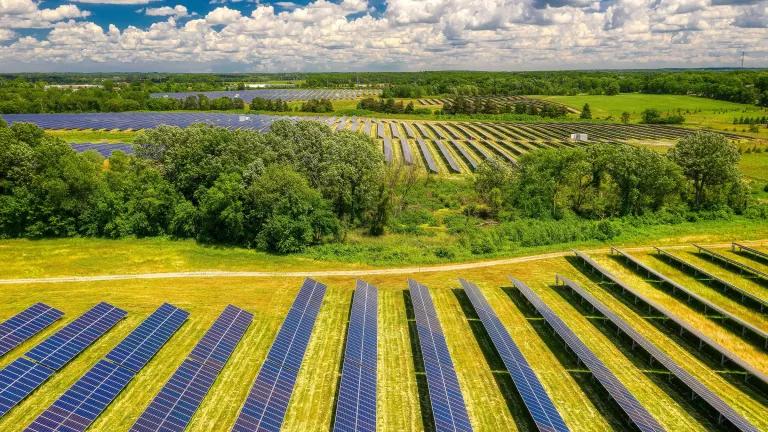Massive Clean Electricity Progress in Sight
Enacting budget reconciliation legislation will accelerate progress toward President Biden’s goal of 80 percent clean electricity by 2030.

A Cherry Street Energy crew installing solar panels at the Palisades Office Park near Interstate 285 in Atlanta, Georgia, on June 24, 2021
Enacting budget reconciliation legislation will accelerate progress toward President Biden’s goal of 80 percent clean electricity by 2030.
Senate Democrats have just announced The Inflation Reduction Act of 2022. As NRDC’s President, Manish Bapna, said: “This is the ultimate clean energy comeback - the strongest climate action yet in the moment we need it most. Congress must pass it without delay.”
Enacting budget reconciliation legislation will accelerate progress toward President Biden’s goal of 80 percent clean electricity by 2030. The bill contains tens of billions in clean electricity tax incentives as well as more than $20 billion for clean energy loans, grants, research, procurement, and other essential programs.
The Clean Electricity Investments
Tax incentives are critical to driving clean energy deployment and reducing the cost of renewables and other clean energy resources. These programs help people and businesses install new clean electricity, like wind and solar, by providing tax credits to buy-down the cost of the projects. The tax incentives included in the legislation are designed with greater flexibility and for increased access to usher in the fastest build-out of renewables the country has ever seen. New bonus credits for projects built in accordance with strong labor standards, using domestically produced components, or based in low-income and energy-transition communities will yield good-paying jobs and drive equitable access to clean energy resources.
In every region across the country, the deployment of existing renewable technologies like onshore wind and solar and energy efficiency will accelerate, as will newer, advanced technologies such as offshore wind. Billions of dollars in federal investments—both grants and loans—will support rural, tribal, and traditionally fossil-energy-dependent communities as they transition to a vibrant clean energy economy. State and local governments and agencies as well as low-income, tribal, and disadvantaged communities will gain access to funding to address local air pollution and reduce power sector emissions.
The incentives in this legislation go well beyond the core clean energy tax credits and agency funding to include:
- additional incentives for solar and wind projects built in low-income communities and on tribal land;
- funding to invest in low-carbon projects in communities impacted by closures of fossil infrastructure like refineries or coal plants;
- funding for loans and grants to transition rural electric co-ops away from fossil fuels.
Benefits for People and the Climate
These credits will usher in the fastest—and most sustained—build-out of renewables and other low- and no-carbon energy resources in the country’s history. Our preliminary analysis indicates that solar and wind capacity in the U.S. could almost triple by the end of this decade, with these power sector investments supporting up to 190,000 new jobs in the renewable energy industry (like for wind technicians or solar installers) by 2030. Wind and solar jobs are already one of the country’s fastest-growing employment categories. Analysis released by E2 shows: “Every day, 3 million Americans across all 435 congressional districts work building our clean energy economy. Clean energy is a critical job creator in every state and district, employing 1 in every 50 American workers, more Americans today work in clean energy than as lawyers, police officers, farmers, firefighters, kindergarten teachers, and mail carriers combined.”
New renewable projects will also lower power prices for all consumers by reducing our exposure to spiking and volatile fossil fuel prices, like we are seeing today. Our analysis suggests the average residential electric bills is likely to be 8% lower by 2030 with, versus without, clean energy tax credits.
This investment in clean energy is estimated to cut power sector carbon (CO2) emissions by up to 320 million metric tons (MMT) annually by 2030. For comparison, that is equal to the annual emissions from all the power plants in Pennsylvania, Texas, and Ohio combined in 2021. In addition, this cleaner, low carbon grid will yield further greenhouse gas reductions economy-wide as the transportation, building, and industrial sectors electrify.
Building out a cleaner electricity system can also lead to large reductions in air pollutants that contribute to local soot, smog, and ozone. Reductions in nitrogen oxides (NOx) and sulfur dioxide (SO2) emissions from power plants due to these clean energy investments could result in up to $9.2 billion in annual public health benefits by 2030. This represents the monetized value of things like avoided premature deaths, reduced ER visits and health care spending, fewer childhood asthma attacks, and fewer missed work and school days due to illness.
[Note: NRDC will be releasing our detailed technical analysis of the benefits of these clean electricity investments in the coming months]
Next Steps
This bill still needs to be passed by the Senate and the House—they must do so rapidly.
Once passed, the new programs and tax incentives will need to be implemented quickly. But the beauty of tax incentives is they are available to anyone that is eligible and there is no need to apply for federal funding – build the project and the benefits will be available.
While this is a crucial step forward, to achieve the President’s clean electricity goals, more action is needed. The EPA, DOE and FERC all need to be using the tools they have under existing law to clean up power sector pollution and deploy clean electricity and associated infrastructure.




